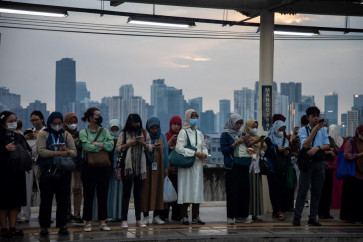Popular Reads
Top Results
Can't find what you're looking for?
View all search resultsPopular Reads
Top Results
Can't find what you're looking for?
View all search resultsA home truth about the house of a Dutch governor-general
(JP/Matheos Viktor Messakh) The house of Reinier de Klerk has its own history that might explain why it is the only buitenverblijen, or 'houses outside' the city, left on Jl
Change text size
Gift Premium Articles
to Anyone
(JP/Matheos Viktor Messakh)
The house of Reinier de Klerk has its own history that might explain why it is the only buitenverblijen, or 'houses outside' the city, left on Jl. Gajah Mada and Jl. Hayam Wuruk.
For a long time during the 18th century, the two roads were the elite quarters of Batavia. They were later replaced by Weltevreden, the area around the present Lapangan Banteng and Medan Merdeka.
De Klerk lived in the house for nearly 20 years before dying there in 1780 as a governor general.
According to Adolf Heuken SJ in his book Historical Sites of Jakarta (Cipta Loka Caraka, 2000), de Klerk's very rich wife Sophia Francina Westpalm supported him throughout much of his career.
The mansion's upstairs is richly furnished with VOC period furniture. (JP/Matheos V. Messakh)
When Sophia married de Klerk in 1754, she was already the widow of a former Council of the Indies member. Her son from her earlier marriage, Francois R. Radermacher, inherited de Klerk's mansion.
In 1786 Radermacher, the son the Batavian Society of Arts and Sciences founder, sold the property to another Council of the Indies member, John Siberg. The house's second owner eventually became governor general between 1801 and 1805, and stayed in the house during the entire French and English period (1808-1816).
After Siberg's death in 1817, the house was auctioned off by his widow and sold the following year, this time to Iehoede Leip Iegiel Igel, a Polish Jew who once served as a low-ranked guard to the house.
The story goes that on a hot day Igel fell asleep while guarding the entrance. When the governor general unexpectedly returned, he was given fifty strokes for his laziness. On that same day, he swore that he would own the premises one day.
(JP/Matheos Viktor Messakh)
After finishing his military service Igel changed his name to Leendert Miero and started work as a goldsmith. He could neither read nor write, yet he made a fortune and bought the Pondok Gede estate.
In 1819 he acquired de Klerk's house and for the next fifteen years invited big crowds to celebrate the anniversary of his lashing day. Igel or Miero had no children from his two legal wives, but adopted his four natural children born to him by four different slaves.
The house was inhabited by Miero's heirs until it was sold again in 1844 to the College of Deacons at the Dutch Reformed Church. When used as an orphanage (until 1900), it suffered several alterations. But after it was sold to the government in 1901, the Greek-style chapel attached to its front was torn down in order to restore the original fa*ade.
For the next 25 years, it served as the office of the Mining Department with little attention being paid to its historic value.
There have been so many wonderful stories written about the events that happened in the mansion.
A box which was used as food container. (JP/Matheos V. Messakh)
It is said that in the simple houses behind de Klerk's mansion more than a hundred slaves lived and worked. Sixteen among them formed a band of musicians and entertained their master and his guests at night.
More than 50 slaves were emancipated and given some money to start their freedom, under the last will of Sophia in 1785. Others bought their emancipation.
The rest, roughly 100 slaves were auctioned off together with their wives and children. This auction took place on Jan. 28, 1786 in front of de Klerk's house.
In 1925 the house was thoroughly restored. Again it shined in its old splendor with its garden landscaped once more. It was used as office of the Landsarchief (State Archive).
The door on the right side of the main building. High ceilings, long and broad windows marked the change in Batavia's architecture style in 18th century after the Dutch conquered the local rulers. (JP/MVM)
The institution was relocated in 1974 to Jl. Ampera Selatan in South Jakarta because humidity was creeping up and into the walls. After the transfer was completed in 1979, the house was no longer used by the national archives body.
The condition of the mid-18th century colonial mansion deteriorated. The paint peeled off and many carvings, doors, and windows split apart. The walls became wet because rain water could not flow into the canal in front of the house.
"The building was in a bad condition. There was half a meter of flooding every rainy season. Many parts of the building were dilapidated," said Tamalia Alisjahbana, executive director of the National Archive Building .
In 1995, some Dutch companies doing business in Jakarta collected money as a gift for the 50th anniversary of Indonesian Independence with the intention of restoring the mansion.
A memorandum was signed during the visit of Queen Beatrix, who gave a reception in this building, but for years no realistic proposals were made by Arsip Nasional.
In order to prevent further damage, the house underwent a thorough restoration from 1997 to 1998. The restoration was done to the highest standard using modern techniques after a careful study of the condition of the building, the problem of drainage and of all old paintings and photos.
An embedded strongbox in the offices of Tuan Besar. (JP/Matheos V. Messakh)
On Nov. 1, 1998, the 1,270-square-meter mansion again regained its splendor.
"The building is believed to have a very good
"They wanted to tear it down in 1900, but it was saved by the Batavian Society. In 1998, they wanted to burn it down, but it was saved because we were completing the restorations.
"There are so many people coming here telling us that the building has a very good vibration, bringing good luck." --JP/Matheos V. Messakh















